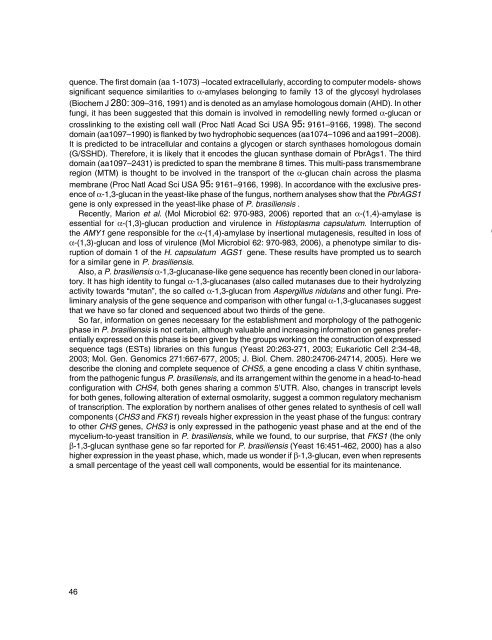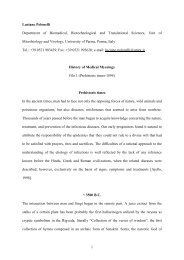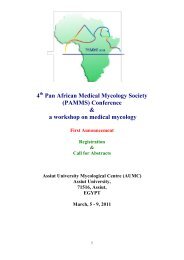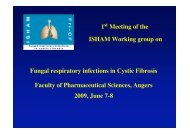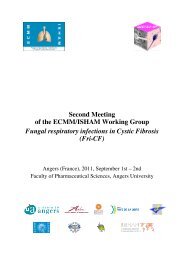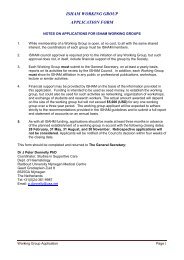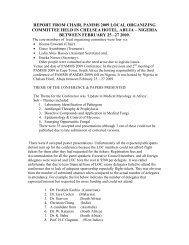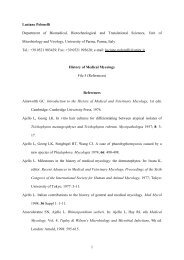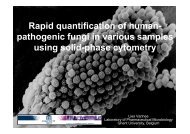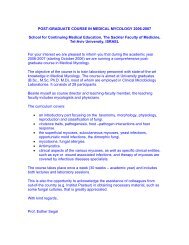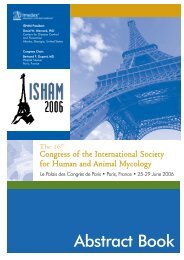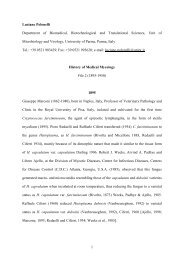Memoria CD.indd - ISHAM
Memoria CD.indd - ISHAM
Memoria CD.indd - ISHAM
You also want an ePaper? Increase the reach of your titles
YUMPU automatically turns print PDFs into web optimized ePapers that Google loves.
quence. The first domain (aa 1-1073) –located extracellularly, according to computer models- showssignificant sequence similarities to α-amylases belonging to family 13 of the glycosyl hydrolases(Biochem J 280: 309–316, 1991) and is denoted as an amylase homologous domain (AHD). In otherfungi, it has been suggested that this domain is involved in remodelling newly formed α-glucan orcrosslinking to the existing cell wall (Proc Natl Acad Sci USA 95: 9161–9166, 1998). The seconddomain (aa1097–1990) is flanked by two hydrophobic sequences (aa1074–1096 and aa1991–2008).It is predicted to be intracellular and contains a glycogen or starch synthases homologous domain(G/SSHD). Therefore, it is likely that it encodes the glucan synthase domain of PbrAgs1. The thirddomain (aa1097–2431) is predicted to span the membrane 8 times. This multi-pass transmembraneregion (MTM) is thought to be involved in the transport of the α-glucan chain across the plasmamembrane (Proc Natl Acad Sci USA 95: 9161–9166, 1998). In accordance with the exclusive presenceof α-1,3-glucan in the yeast-like phase of the fungus, northern analyses show that the PbrAGS1gene is only expressed in the yeast-like phase of P. brasiliensis .Recently, Marion et al. (Mol Microbiol 62: 970-983, 2006) reported that an α-(1,4)-amylase isessential for α-(1,3)-glucan production and virulence in Histoplasma capsulatum. Interruption ofthe AMY1 gene responsible for the α-(1,4)-amylase by insertional mutagenesis, resulted in loss ofα-(1,3)-glucan and loss of virulence (Mol Microbiol 62: 970-983, 2006), a phenotype similar to disruptionof domain 1 of the H. capsulatum AGS1 gene. These results have prompted us to searchfor a similar gene in P. brasiliensis.Also, a P. brasiliensis α-1,3-glucanase-like gene sequence has recently been cloned in our laboratory.It has high identity to fungal α-1,3-glucanases (also called mutanases due to their hydrolyzingactivity towards “mutan”, the so called α-1,3-glucan from Aspergillus nidulans and other fungi. Preliminaryanalysis of the gene sequence and comparison with other fungal α-1,3-glucanases suggestthat we have so far cloned and sequenced about two thirds of the gene.So far, information on genes necessary for the establishment and morphology of the pathogenicphase in P. brasiliensis is not certain, although valuable and increasing information on genes preferentiallyexpressed on this phase is been given by the groups working on the construction of expressedsequence tags (ESTs) libraries on this fungus (Yeast 20:263-271, 2003; Eukariotic Cell 2:34-48,2003; Mol. Gen. Genomics 271:667-677, 2005; J. Biol. Chem. 280:24706-24714, 2005). Here wedescribe the cloning and complete sequence of CHS5, a gene encoding a class V chitin synthase,from the pathogenic fungus P. brasiliensis, and its arrangement within the genome in a head-to-headconfiguration with CHS4, both genes sharing a common 5’UTR. Also, changes in transcript levelsfor both genes, following alteration of external osmolarity, suggest a common regulatory mechanismof transcription. The exploration by northern analises of other genes related to synthesis of cell wallcomponents (CHS3 and FKS1) reveals higher expression in the yeast phase of the fungus: contraryto other CHS genes, CHS3 is only expressed in the pathogenic yeast phase and at the end of themycelium-to-yeast transition in P. brasiliensis, while we found, to our surprise, that FKS1 (the onlyβ-1,3-glucan synthase gene so far reported for P. brasiliensis (Yeast 16:451-462, 2000) has a alsohigher expression in the yeast phase, which, made us wonder if β-1,3-glucan, even when representsa small percentage of the yeast cell wall components, would be essential for its maintenance.46


